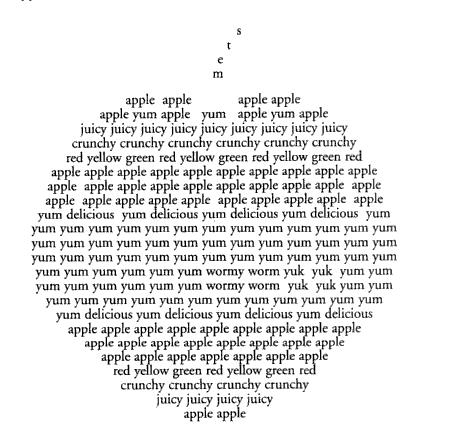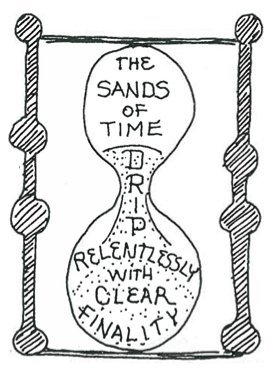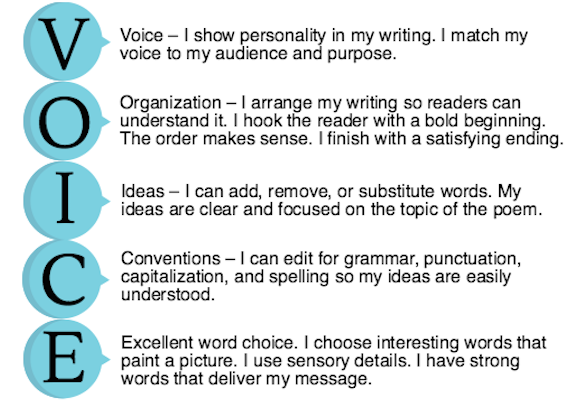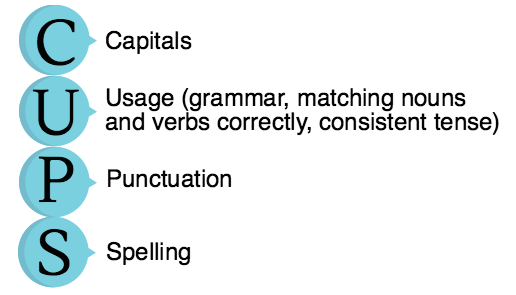4.8 Street Music and Apples
| Site: | Cowichan Valley School District - Moodle |
| Course: | ELA5, CSS, Sferrazza |
| Book: | 4.8 Street Music and Apples |
| Printed by: | Guest user |
| Date: | Monday, 15 December 2025, 11:10 AM |
Learning Target
By the end of this lesson, you should be able to say YES to the following questions.
- Can I identify characteristics of concrete poetry in the poems ‘Street Music’ and ‘The Apple?
- Can I use onomatopoeia to enhance your poetry composition?
(It is much tricker to pronounce than to use... This is how you say it:)
- Can I use language in creative and playful ways to develop style?
- Can I use writing and design processes to plan, develop, and create texts for a variety of purposes and audiences?

Big Question...
Why would writers use sounds in a text even though you can’t actually hear them?
Onomatopoeia
You explored onomatopoeia earlier in this course so you already know that it is a word that represents a sound. Find the onomatopoeia in each of the sentences below:
- The fly buzzed past the flower.
- Dylan clattered and clanged at the sink as he washed the dishes.
- The chicken clucked as it scratched at the ground.
- As the thunder rumbled in the distance, she could hear the rain patter on the roof.
In your Learning Guide, under City Sounds and Nature Sounds, list seven sounds you think you'd hear in the city and in nature. For example, you may hear "horns honking".

Street Music
The poem “Street Music”. by Arnold Adoff, is quite different from the poems you've read so far.
1. Look at the poem in your Learning Guide. What do you notice about the structure of this poem? Come up with your own ideas before checking below. If your ideas are not exactly the same, that is OK.
2. Listen to the video introduction; then, read the poem aloud (following along in your Learning Guide) with the recording at least twice. Pay attention to the structure of the poem and see if you can find the onomatopeia.
Irregular
What does ‘irregular’ mean? Can you see a familiar word inside this word – the root word?
The root word is “regular” and the “ir-” is an prefix, something you add to the beginning of a word to change its meaning.
Here are some examples of other prefixes:
“un-” means not, so if you add “un-” to happy, you change it unhappy. This means "not happy".
The prefix “ir-” also means not, so irregular means ‘not regular’. So what do you think ‘irregular structure’ (like the structure of Street Music) means?
Onomatopoeia
See if you can find and underline five examples of onomatopoeia that can you find in Arnold Adoff’s poem, Street Music, in your Learning Guide. Then check below to see if you found them all.
Concrete Poetry
Concrete poetry has irregular structure.
In concrete poetry, the words themselves may form a picture on the page.
Look at the “Apple Poem” by S.C. Rigg (below)
What are some onomatopoeia words that could be added to enhance this poem? What sound is made when you bite into an apple? When you chew it?
This poem uses repetition. Notice how words are repeated to create an interesting effect
Read the words in the poem, line by line from top to bottom.

Source: Creech, S. (2001). Love that dog. New York: HarperCollins.
Can you picture the apple? Taste the deliciousness? Feel the crunch? Smell the juice? Even in a concrete poem like this, the words can create be powerful.
Even More Concrete Poetry
Here is a three-liner in an hourglass. Can you find the onomatopeia?

Complete Reflection in your Learning Guide. Then return to this lesson.

Your Turn - 1
Your task is to write an "irregular" poem about anything to do with nature (or any topic of your choice).
Structure it in a random way (like The Street) or make it a concrete poem by confining it to a shape (like The Apple and The Sands of Time).
Include two or more onomatopeia words.
 Complete the steps in your Learning Guide as outlined here in this lesson.
Complete the steps in your Learning Guide as outlined here in this lesson.

- Decide on a topic.
- Decide if you will use a shape or not.
- Brainstorm a list of five to seven words that would help a reader see, smell, taste, hear, or feel what you will write a poem about.
- Add two or more onomatopeia words you could use for your topic.

Draft your poem. If you are writing a concrete poem, first lightly sketch the shape of your picture. In The Apple, words were repeated to create an interesting effect. In The Sands of Time, words were not repeated. You can decide whether or not repetition enhances your poem.
Revising
![]()
Make changes to improve your writing. While making this changes, think VOICE:

Editing

- Patrol your writing for CUPS. Make corrections as needed.

Next Steps
 The next step in the writing process is "Evaluating". In your Learning Guide, think and talk about the evaluating questions with your home facilitator. Decide how well you think your rough draft meets the criteria. Revise and edit your poem more, if you feel it is needed.
The next step in the writing process is "Evaluating". In your Learning Guide, think and talk about the evaluating questions with your home facilitator. Decide how well you think your rough draft meets the criteria. Revise and edit your poem more, if you feel it is needed.

 The last step is "Publishing". This step will be saved for project choices at the end of the poetry unit. For now, this lesson and poem are completed. Congratulations!
The last step is "Publishing". This step will be saved for project choices at the end of the poetry unit. For now, this lesson and poem are completed. Congratulations!

Do you have someone you can share your poem with now?
Reminder
In the next day or so, read some poems independently. Did you know you could include song lyrics as a form of poetry? Then, add to your poetry reading journal to show your independent reading reflections.
